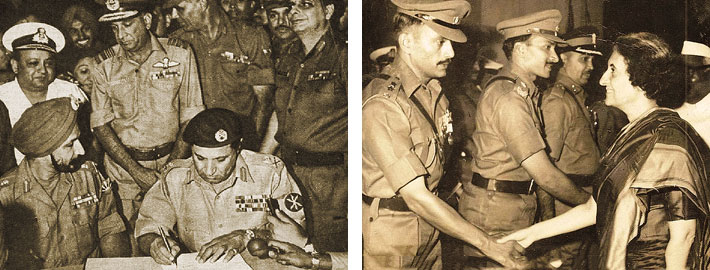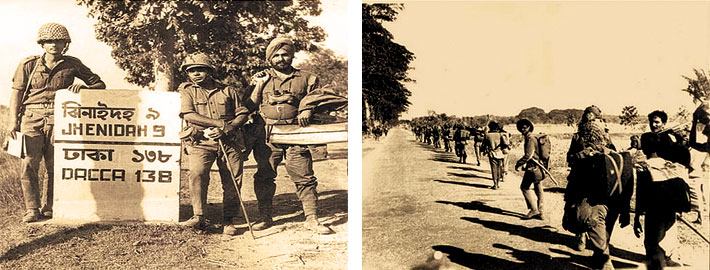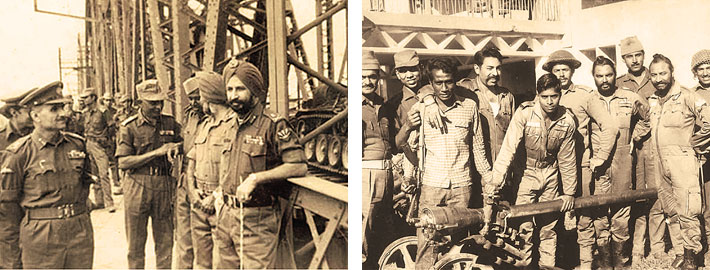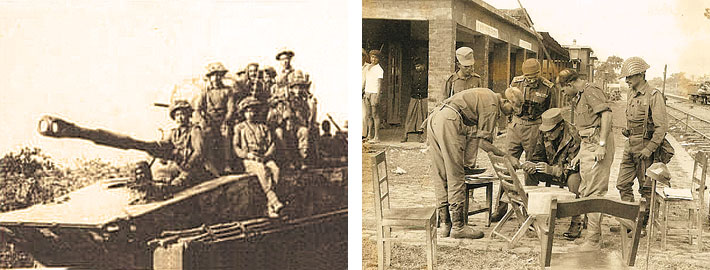INDIAN ARMED FORCES CHIEFS ON
OUR RELENTLESS AND FOCUSED PUBLISHING EFFORTS

SP Guide Publications puts forth a well compiled articulation of issues, pursuits and accomplishments of the Indian Army, over the years

I am confident that SP Guide Publications would continue to inform, inspire and influence.

My compliments to SP Guide Publications for informative and credible reportage on contemporary aerospace issues over the past six decades.
- Interim Defence Budget 2024-25 — An Analysis
- Union Defence budget 2024
- Indian Army: In quest of greater firepower and policy recommendations for gaps
- Indian Army Annual Press Conference 2024
- 6G will transform military-industrial applications
- Tata Boeing Aerospace Delivers 250 AH-64 Apache Fuselages, Manufactured in India
1971 – India’s Greatest Victory
As India celebrates 50 years of victory in the 1971 war with Pakistan, SP’s Land Forces looks at how the Indian Army with the support of the IAF and the Indian Navy, bulldozed its way to the liberation of East Pakistan (later Bangladesh) to achieve one of the greatest victories by any modern-day military


The demolition of East Pakistan leading to the birth of Bangladesh in 1971 was the greatest victory of India that resulted in the surrender of 93,000 Pakistani military personnel – the largest number of prisoners taken in any war after World War II. It would not be wrong to say that Pakistan had been digging its own grave in East Pakistan since long that accelerated its collapse. Ironically, western media didn’t mention much about this magnificent Indian victory and the West never took up this campaign as a case study because both the US and Britain were against the Indian action.
Setting in East Pakistan
Continuing oppressive actions in East Pakistan under directions of the West Pakistan-based military junta led by President Yahya Khan had germinated simmering Bengali nationalism since a long time. This led to the movement of self determination when the military junta annulled results of the general elections held on December 7, 1970, in which the Awami League had won a decisive majority capturing 167 out of 313 seats. The Bengali population expected a swift transfer of power to the Awami League but this was nixed and the national assembly meeting scheduled for March 1971 was postponed. In response, the Awami League held a massive rally on March 7 and launched a programme of non-co-operation, which was hugely successful. However, Prime Minister-designate Sheikh Mujibur Rehman was arrested and taken to West Pakistan. On the night of March 25, 1971, Pakistan launched Operation ‘Searchlight’ against the people of East Pakistan under Lieutenant General Tikka Khan, Governor and General Officer Commanding, East Pakistan. This involved systematic elimination of nationalist Bengali civilians, students, scholars and intelligentsia, religious minorities, resistance fighters and supporters.
Operation ‘Searchlight’ aimed to eliminate the Awami League structure and their support elements including civilians and armed forces personnel. Imposition of martial law authorised free hand in using maximum force for assault and genocide in civil areas. The mandate given to the army included: simultaneous operations across East Pakistan; arresting maximum political, student, cultural organisation leaders and teaching staff; must achieve 100 per cent success in Dhaka University – searching and ‘occupying’ the premises; freedom of fire to secure cantonments; domestic and international communications to be cut - including telephone, television, radio and telegraph; all Bengali troops to be neutralised seizing their weapons and ammunition, and; continue dialogue with Awami League pretending to agree to their demands.
By April 10, Pakistan had airlifted two Infantry Divisions (9 and 18) from West to East Pakistan and had gained control of Dhaka, Rangpur-Saidpur, Comilla, Chittagong, and Khulna but lost or abandoned Rajshahi, Sylhet, Pabna, Dinajpur, Mymenshing and Kushtia. Lieutenant General A.A.K. Niazi, who assumed command of Pakistan forces in East Pakistan on April 11, had planned following strategy: clear all the big cities of insurgents and secure Chittagong; take control and open all river, highway and rail communication network; drive the insurgents away from interior of the country; launch combing operations across Bangladesh to wipe out the insurgent network.
During the Awami League rally on March 7, Sheikh Mujibur Rehman gave a call to the public to prepare for an allout struggle. Post the launch of Operation ‘Searchlight’, formal military leadership of the resistance was created in April 1971 under the Provisional Government of Bangladesh. The Bangladesh Armed Forces were officially established on April 4, 1971. Pakistani army operations under Niazi continued to be resisted by the Mukti Bahini. However, the resistance needed support to overwhelm the Pakistani military especially with Niazi using cities for fortress defence.
The Pakistani army genocide resulted in some 10 million refugees fleeing to India and over 30 million internally displaced. Bangladesh government figures estimate some three million people were killed by the Pakistani army but independent researchers put the figure at between 3,00,000 and 5,00,000. On September 21, 2017, Bangladesh Prime Minister Sheikh Hasina addressing the United Nations General Assembly said, “In the 1971 war of liberation, we endured an extreme form of genocide. In the 9-month-long war of liberation against Pakistan three million innocent people were killed and more than 2,00,000 women were violated. The Pakistan military launched the heinous ‘Operation Searchlight’ on 25th March which was the beginning of the 1971 genocide. The 1971 genocide included targeted elimination of individuals on the ground of religion, race and political belief. The intellectuals were killed brutally.” Hasina added that the Bangladesh Parliament had declared March 25 as ‘Genocide Day’ to pay homage to the victims.
The Scene in India
India was flooded with some 10 million refugees from East Pakistan as mentioned above. Setting up camps and administering this large number was a herculean task that stressed out the state administration especially in West Bengal, Assam and Tripura. India had allowed the refugees including resistance fighters to cross the border at will. Bangladeshi liberation fighters-led training camps came up in multiple states like Bihar, Arunachal Pradesh, Assam, Nagaland, Mizoram, Meghalaya, Tripura and West Bengal. With refugees pouring in, Prime Minister Indira Gandhi was under pressure to act. She held a cabinet meeting on April 28, 1971 and ordered the Chief of the Army Staff General (later Field Marshal) SHFJ ‘Sam’ Manekshaw to enter Pakistan but Sam told her it was not the right time.


How Sam responded to the Prime Minister’s dictum was covered in his talk at the Field Marshal K.M. Cariappa Memorial Lecture in New Delhi during October 1995, wherein he said:
- “There is a very thin line between being dismissed and becoming a Field Marshal. In 1971, when Pakistan cracked down in East Pakistan, hundreds and thousands of refugees started pouring into India, into West Bengal, Assam and Tripura. The Prime Minister held a Cabinet meeting in her office. I was then summoned. A very angry, grim-faced Prime Minister read out telegrams from the Chief Ministers of West Bengal, Assam and Tripura. She then turned around to me and said, ‘What are you doing about it?’ And I said, ‘Nothing, it’s got nothing to do with me. You didn’t consult me when you allowed the BSF, the CRP and RAW to encourage the Pakistanis (East Pakistanis) to revolt. Now that you are in trouble, you come to me. I have a long nose. I know what’s happening.’
- She said, ‘I want you to enter Pakistan. And I responded, That means war!’ She said, ‘I do not mind if it is war.’ I said ‘Are you prepared? I am certainly not. This is the end of April. The Himalayan passes are opening and there can be an attack from China.’ I turned around to the Prime Minister and said that the rains were about to start in East Pakistan and when it rains there, it pours and the whole countryside is flooded. The snows are melting, the rivers would become like oceans. All my movement would be confined to roads. ‘Now Prime Minister, give me your orders’.
- The grim Prime Minister with her teeth clenched said, ‘The Cabinet will meet again at four o’clock.’ The Cabinet members started walking out. I being the junior most was the last to go and as I was leaving, she said, ‘Chief, will you stay back?’ I turned around and said, ‘Prime Minister, before you open your mouth, may I send you my resignation on grounds of health, mental or physical?’ She said, ‘Everything you told me is true.’ ‘Yes! It is my job to tell you the truth,’ I responded. ‘And it is my job to fight, it is my job to fight to win and I have to tell you the truth.’ She smiled at me and said, ‘All right Sam, you know what I want?’ I said, ‘Yes, I know what you want!’
Sam was not the type who would say he can walk into East Pakistan, Pakistan Occupied Kashmir or Aksai Chin anytime the government wants – they just have to give the word. He placed the Constitution and the troops under him above political appeasement. At that time three infantry divisions without their heavy weapons at that time were deployed in West Bengal in penny packets to ensure peace during elections and were. Large number of tanks in the Army was unserviceable because of shortage of spares with bureaucracy not releasing funds to buy spares.
India eventually launched operations seven months later in November 1971. The intervening period was gainfully used for detailed tri-service planning, integration, training and equipping the Army for an operation of this magnitude never launched before. Army also took over the task of training and guiding the Mukti Bahini as Sam wanted; three brigade groups of regular Bangladesh troops (part of Mukti Bahini) organised, trained and equipped for functioning independently, in addition to training and equipping over 70,000 plus guerilla fighters.
Declaration of War
On the evening of December 3, Pakistan Air Force (PAF) launched surprise pre-emptive strikes on eleven airfields in north-western India, including at Agra - 480 kilometres from India’s Western border. Addressing the nation same evening on radio, Prime Minister Indira Gandhi said that the air strikes were a declaration of war by Pakistan against India. India responded with air strikes in West Pakistan the same night. In the east, the Indian Army and the Mukti Bahini had already entered East Pakistan in November.
Sam wanted a quick decisive campaign before any foreign intervention could come; multi-pronged thrusts from the East, North and West with Navy blockading ports and Air Force destroying PAF assets on ground or in the air. Detailed planning and preparation for the operations plus preparing Mukti Bahini fell on Lieutenant General Jagjit Singh Aurora, GOC-in-C Eastern Command. Eastern Command was given the required tanks, artillery, bridging and river crossing equipment concurrent to building road building to bases proximate to the border for launching the attacking formations. The three mighty rivers, namely Ganga (called Padma in Bangladesh), Brahmaputra and Meghna and their tributaries posed problems together with limited roads and likely enemy action of destroying bridges to impede progress.
The campaign got going with the Indian Army supported by three brigades of the Mukti Bahini and the Bengali guerrilla army. The Mukti Bahini and its supporters were invaluable as guides and providing information about Pakistani troop movements. Overall the Indian Army and Mukti Bahini greatly outnumbered the three Pakistani army divisions. Major joint engagements occurred in the battles for Sylhet, Garibpur, Boyra, Hilli and Kushita. The strategy of swiftly capturing surrounding areas by selectively engaging or bypassing heavily defended strongholds worked beautifully. The cities of Jessore, Mymensingh, Sylhet, Kushita, Noakhali and Moulvibazar were quickly taken. Operations of the three Corps were closely coordinated. Innovations were done in transporting troops across rivers in using helicopters big and small.
In a final attempt to eliminate the Bengali intelligentsia, the Pakistan army began mass murder of Bengali intellectuals and professionals in Dhaka. The campaign saw the first ever parachute drop of an Indian airborne battle group in operations centered on 2 PARA from the Parachute Regiment. This was the brainchild of Brigadier (later Lieutenant General) I.S. Gill, himself a dare-devil paratrooper, who was the Director of Military Operations at Army Headquarters. Well known as ‘Inder’ Gill was awarded the Military Cross on February 3, 1944 for bravery while serving in the Corps of Royal Engineers as a young officer. He resigned from the British Army just before Independence and joined the Indian Army. He had an excellent rapport with Sam. The airborne drop at Tangail with Mukti Bahini in the area was hugely successful and a psychological blow to the Pakistani army. Elements of 2 PARA were the first Indian troops to enter Dhaka.
On December 14, within 15 minutes of intercepting a message about a high-level meeting in Dhaka, four Indian Air Force (IAF) MiGs blasted the Governor’s House in Dhaka, which shook the Pakistanis completely. From December 14, Niazi had begun making efforts to obtain a ceasefire. On the evening of December 15, Yahya Khan was hosting a house warming party for his new house in Peshawar. Among the few guests was Mrs Shamim, Yahya’s latest sleeping partner – better known as ‘Black Pearl’ whom he had appointed Pakistan’s ambassador to Austria. Later that evening Yahya slurred on Radio Pakistan that he will fight India for 100 years.
On the morning of December 16, 1971, Major General (later Lieutenant General) J.F.R. Jacob, Chief of Staff Eastern Command flew to Dhaka on orders of Sam Manekshaw to obtain surrender of the Pakistani forces. Jacob met Niazi in his office, showed him the surrender document and told him, “I will give you 30 minutes and if you do not agree, I will order the resumption of hostilities and the bombing of Dhaka. I have offered you terms that you will be treated with respect and under Geneva conventions. We will protect all ethnic minorities and everyone. If you surrender, we will protect you. If you do not surrender, I wash my hands of anything that happens.” The surrender ceremony was signed the same evening by Lieutenant General J.S. Aurora and Lieutenant General A.A.K. Niazi after which Niazi handed over his revolver to Aurora with a trembling hand. East Pakistan had ceased to exist with total surrender of Pakistani forces.
The IAF did a wonderful job supporting ground operations and knocking out Pakistani Air Force (PAF) assets in East Pakistan both on ground and in dogfights. IAF helped Mukti Bahini organise a formation of light aircraft (named Kilo Flight) manned and serviced by Bengali pilots and technicians who had defected from the Pakistani Air Force. Kilo Flight attacked targets in East Pakistan on December 3, 1971 prior to IAF involvement from December 4. By December 7, Tejgaon airfield was put out of operation, grounding PAF in East Pakistan. The IAF flew interdiction missions during the war blowing up ammunition dumps and other fixed installations. Gnats and Sukhoi Su-7s flew many missions in support of army units as they moved swiftly towards Dhaka including a heliborne assault by two infantry companies across Meghna River near Sylhet on December 7. Canberras repeatedly struck Jessore, forcing the enemy to abandon the strategic city.
Naval aircraft from INS ‘Vikrant’ operated bombing missions in Bangladesh while Indian Navy blockaded East Pakistan ports. Navy and the Mukti Bahini established a naval commando force to target Pakistani assets with eight defectors and 15 more Bangladeshi seamen forming its nucleus force. A secret training camp ‘C2P’ was established at Plassey in West Bengal that trained over 500 personnel including combatants, university students and other civilians. On August 15, nine ships in Chittagong harbour were blown up by frogmen using limpet mines under Operation ‘Jackpot’. By November, naval commandos sank over 1,00,000 tonnes of shipping. The fighters were then provided gunboats; two patrol boats were also loaned by the Indian Navy. This flotilla struck Pakistani and allied ships in the sub-campaign ‘Operation Hotpants’. Ports, rivers and waterways were soon clogged with damaged or sunken vessels.
An interesting event was the deployment of India’s Special Frontier Force in Chittagong operating under R&AW. The Pakistani army thought the Chinese had come to their rescue till reality dawned. India had tried all diplomatic efforts to avert the war by conveying to the world the plight of Bangladeshi refugees. The Prime Minister also visited few foreign countries for the same reason. However, India only received sympathy in response. The US sent an aircraft carrier in the Bay of Bengal to scare India for any action in East Pakistan. The British sent a naval contingent to the Arabian Sea but turned tail when Russian submarines surfaced up in their route.
Aftermath
Sheikh Mujibur Rehman, who had been released from jail under international pressure, went to London. He returned to Bangladesh via India after the Pakistan surrender in East Pakistan and took oath as the Prime Minister of Bangladesh.
Indian Armed Forces returned to India along with 93,000 Pakistani POWs.
On July 2, 1972, the Shimla Agreement was signed between Pakistan President Zulfikar Ali Bhutto and PM Indira Gandhi. Bhutto promised to resolve the Kashmir issue but did not want it to be put on paper on grounds his government would fall. He later reneged on the promise.
India returned 93,000 POWs to Pakistan without obtaining the release of 54 Indian POWs languishing in Pakistani jails.
Officers passing out from Pakistan Military Academy, Kakul continue to take an oath they will avenge the loss of East Pakistan. Pakistan army accelerated generation of terrorism but anticipating that chickens will eventually come home to roost sold their soul and territorial sovereignty of Pakistan to China.
In August 2020, Prime Minister Sheikh Hasina-led Government of Bangladesh selected 3.5 acres of land in Ashuganj in Brahmanbaria District bordering Tripura to construct a standalone War Memorial for Indian soldiers who had laid down their lives fighting for the liberation of Bangladesh in 1971.
Sam Manekshaw later said, “I got everything I wanted. I got the money. I went to the Soviet Union and got Soviet tanks; went elsewhere, got the equipment I wanted much against the wishes of the bureaucracy; they don’t like such things coming into the hands of the Service Chief, especially a Service Chief who took no notice of them. It was all done against their opposition but I had the Prime Minister’s support. She knew what the aim was and she understood that this man would carry it out”. Sadly after Sam, the bureaucracy has continued to rule the roost over Service Chiefs. The practice that Prime Minister Narendra Modi started in meeting Service Chiefs periodically in 2014, ceased quickly thereafter. The Chief of Defence Staff is not even an advisor to the Prime Minister.





